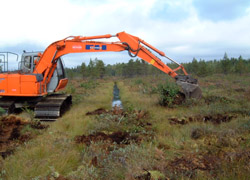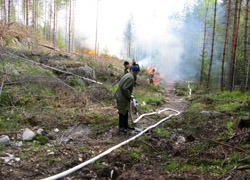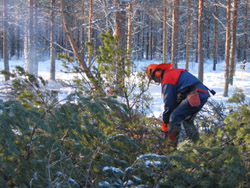Overview
In October 2002, the Government of Finland approved the Forest Biodiversity Programme for Southern Finland (METSO). METSO was designed as a land management strategy that would bring important tracts of privately held forest into a national conservation framework. Unlike previous conservation programmes that lacked provisions for interfacing with landowners, and thus failed to protect important areas, METSO centers around close cooperation with forest owners and allows programme managers to tailor a conservation strategy that suits the particular circumstances of a given owner, while simultaneously contributing to larger programme goals. Besides measures to address private land issues, METSO also encompasses the Forest Life project, an initiative implemented in association with the European Union’s Life-Nature programme and managed by the Finnish forestry division MetsÁ¤hallitus. Forest Life has worked to restore and protect 33 nature conservation areas from Southern Finland to Lapland, and outcomes have been favorable to this point. Ultimately, restoration activities are expected to directly benefit more than 33,000 hectares, and partnerships with property owners many more.
Quick Facts
Project Location:
Finland, 61.92410999999999, 25.748151099999973
Geographic Region:
Europe
Country or Territory:
Finland
Biome:
Taiga
Ecosystem:
Temperate Forest - Coniferous
Area being restored:
33,000 hectares
Project Lead:
Government of Finland
Organization Type:
Governmental Body
Location
Project Stage:
Implementation
Start Date:
2002-10-17
End Date:
2007-12-17
Primary Causes of Degradation
Agriculture & Livestock, Mining & Resource ExtractionDegradation Description
Almost every area of forest in Southern Finland has at some time in the past been exploited for timber, tar-making or shifting cultivation, and many areas with nutrient-rich soils have been permanently cleared to create fields. Therefore, although the region is still largely covered by forest, few areas are preserved in a completely natural state. Fire suppression as a forest management practice has also had a detrimental impact on Finland’s forest ecosystems, as species adapted to the special environment created by periodic fires are in danger of disappearing.
Reference Ecosystem Description
In all, Finland has about thirty indigenous tree species. The softwood species include: Pine (Pinus sylvestris), Spruce (Picea abies), Common Juniper (Juniperus communis), and Common or European or English Yew (Taxus baccata). The hardwood species include: Silver Birch (Betula pendula), Downy Birch (Betula pubescens), Common or European Alder (Alnus glutinosa), Grey Alder (Alnus incana), Aspen (Populus tremula), Rowan (Rosaceae), European Mountain Ash (Sorbus aucuparia), Oaklef Mountain Ash (Sorbus hybrida), Swedish Whitebeam (Sorbus intermedia), Teodori Rowan (Sorbys teodori), European Bird Cherry (Prunus padus), Littleleaf Linden (Tilia cordata), Norway Maple(Acer platanoides), Common or English or Pedunculate Oak (Quercus robur), Common or European Ash (Fraxinus excelsior), Wych Elm (Ulmus glabra), European White Elm (Ulmus laevis), Crab Apple (Malus sylvestris), Common Buckthorn (Rhamnus catharticus), Alder or Glossy Buckthorn (Rhamnus frangula), Hawnthorn (Crataegus monogyna), Goat Willow (Salix caprea), Bay or Laurel Willow (Salix pentandra), Black Maul or Almond-leaved Willow (Salix triandra), and Dark-leaved Willow (Salix myrsinifolia).
Important faunal species in the Finnish forests are: Brown Bear (Ursus arctos), Grey Wolf (Canis lupus), Elk (Alces alces), Arctic Fox (Alopex lagopus), Golden Eagle (Aquila chrysaetos), Peregrine Falcon (Falco peregrinus), Gyrfalcon (Falco rusticolus), White-backed woodpecker (Dendrocopos leucotos), Flat Bark Beetle (Cucujus cinnaberinus), Speckled Grasshopper (Bryodema tuberculatum), Baton Blue (Scolitantides vicrama), Silver-spotted Skipper (Hesperia comma ssp. catena), and Lesser White-fronted Goose (Anser erythropus ) in the Northern Lapland.
Project Goals
The METSO Programme aims to preserve valuable forest habitats, while, at the same time, allowing forests to be commercially utilised for the benefit of rural economies and livelihoods. It is hoped that this approach will help promote sustainable development in rural regions of Finland.
Monitoring
The project does not have a monitoring plan.
Stakeholders
The compulsory protection of extensive areas of privately owned forest would be prohibitively expensive and unpopular. Therefore, the METSO Programme has placed particular emphasis on working closely with landowners and maintaining an open, transparent decision-making process that ensures public participation at every level. Consequently, landowners and other interest groups, such as forest industry representatives, forestry workers’ associations and environmental organizations, have all been actively involved in the planning and implementation of the programme.
Description of Project Activities:
METSO is an ambitious programme designed to ensure the conservation, protection and restoration of important ecosystems throughout Finland. Due to the nature of land ownership there, programme planners have had to devise a number of management strategies to suit particular circumstances. Much of the nation's forests (more than two-thirds) are privately owned, and collaboration and liaising with property owners has been an important means of fostering long-term conservation.
A number of projects have been developed to encourage the cooperation and participation of these landowners. Natural values trading, for instance, is a programme that allows owners to sign a contract promising to maintain and/or enhance valuable natural features of their forests over a certain period in exchange for monetary compensation. Competitive tendering is another programme whereby owners rent or sell ecologically valuable sections of their forests to the government for conservation. Another project, known as forest biodiversity cooperation networks, was designed to encourage dialogue, idea sharing and partnerships among landowners, local environmental and forest authorities, and other interest groups. Finally, nature management areas, although not yet widely instituted, will be established in sections of privately held forest with high ecological value, and land use will be carefully planned to ensure future conservation and protection.
In cases where important sites are publicly owned, restoration activities have been conducted through a METSO sub-programme, the Forest Life project. Thirty-three nature conservation areas have been targeted for restoration, based on their potential to expand or unite separate bodies of forest or mire that are in a natural-like state. Specific restoration activities have been tailored to the different ecosystems represented.
Forested sites have been restored by conducting controlled burns, promoting the structural diversity of forests through the creation of small clearings, and increasing the amount of dead and decaying wood by damaging trees.
Forest-covered mires are being restored through the re-creation of natural hydrology by damming and obstructing drainage ditches. Ditches are blocked with peat from the banks, and in several cases, dams have been constructed with wood, mineral soil, or rocks. In some mires, trees are also felled in order to create a more open landscape structure and help prevent evaporation.
In esker forests, degradation has resulted mainly from fire suppression and resultant overgrowth. Consequently, restoration involves creating small clearings, conducting controlled burns to imitate a forest fire, and increasing the amount of decaying wood.
Habitat for the white-backed woodpecker, a critically endangered species in Finland, has also been a major focus of restoration, as the decrease in old deciduous forests with large amounts of dead wood is threatening its survival further. The maintenance of forests inhabited by white-backed woodpeckers consists partially of the same methods used in forest restoration: creating small clearings and increasing the amount of dead and decaying wood by felling trees, damaging standing trees and clearing. When the forests in question are groves, the stacking and removal of clearing waste is necessary, as this waste consists mainly of spruce needles that acidify the soil.
Lastly, road surfaces have been reforested in some cases in order to rejoin sections of forest and discourage motor vehicle traffic that might disturb the nesting of birds. Excavators are used to loosen the soil on the roadbed and facilitate the germination of seeds and recolonization of saplings. Saplings growing on or near the banks of the road can be relocated directly on the road track, further accelerating the recovery process. In areas with rocky terrain, an excavator is used to move large rocks onto the road track, enhancing the aesthetic quality of the site.
Ecological Outcomes Achieved
Eliminate existing threats to the ecosystem:
Actions taken under the METSO Programme have directly contributed to the restoration of the following:
- 5108 hectares of forest, at 31 sites (289 hectares by controlled burning, 2310 hectares by increasing the amount of decaying wood, and 2509 hectares by creating small clearings)
- 339 hectares of forest-covered mires, at 10 sites
- 513 hectares of esker forest, at one site
- 178 hectares of forest inhabited by white-backed woodpeckers, at 3 sites
Socio-Economic & Community Outcomes Achieved
Economic vitality and local livelihoods:
The restoration work conducted under this programme has provided valuable opportunities for employees of the MetsÁ¤hallitus Forestry Division. Theoretical and practical training in restoration has been organised in several different places throughout Finland. In the winter of 2003, lectures were held in four towns in southern Finland, and 180 people took part in this training. About 300 forest workers and other employees took part in the actual field training. Thus, employees are afforded the chance to learn new skills and become involved in a long-term national programme from the outset.
Key Lessons Learned
The METSO Programme has successfully created a new approach with regard to forest conservation, and expanded the variety of tools available for safeguarding forest biodiversity. The network of forests under some form of protection in Southern Finland can be considerably extended into privately owned forests thanks to measures within METSO. But it remains clear that a representative network of protected forests can only be built up with involvement from all types of forest owners, especially the State, municipalities, forest industry companies and other major owners. Many of the sites included in conservation programmes–privately-owned protected areas, sites protected under the Forest Act, and sites covered by pilot projects within the METSO Programme–are small in size. Even within protected areas, ecologically valuable biotopes may be separated from other sites with similar habitat, and this presents a problem, especially for threatened species. A comprehensive assessment is needed to facilitate the establishment of a more extensive and interlinked network of protected areas.
Long-Term Management
Within the METSO region, very little consideration has thus far been to systematic landscape ecological planning at a scale greater than forest ownership boundaries. The “˜ecosystem approach’, which comprehensively examines natural processes and resource use practices over a large area, would help facilitate the effective establishment of broad conservation networks. In planning these networks, more attention should be given in the future to the need for preserving genetic diversity within species, since this may considerably improve the prospects for the preservation of their populations, particularly considering the possible impacts of climate change.
Sources and Amounts of Funding
62 million Euros METSO is funded largely through Finland’s national budget, although the European Union has also provided funding for some aspects of the programme (i.e. the Forest Life project). Approximately sixty-two million euros have been allocated to METSO for the period 2003-2007.
Other Resources
The Forest Biodiversity Program for Southern Finland (METSO)
URL: http://wwwb.mmm.fi/metso/international/index.html
MetsÁ¤hallitus
URL: www.metsa.fi




